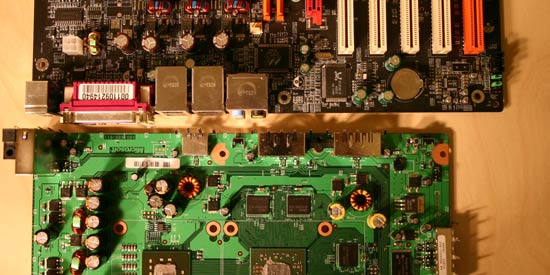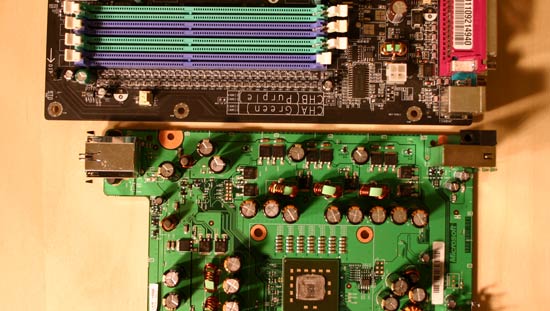Inside Microsoft's Xbox 360 - A Tour of the 360's Motherboard
by Anand Lal Shimpi on November 18, 2005 12:19 AM EST- Posted in
- Systems
On Wednesday we took apart the Xbox 360 to satisfy our curiosities and provide a tutorial to all those willing to take time out of gaming in order to take theirs apart as well. Today, we take a bit of a different approach, focusing on one item within the sleekly design chassis in particular - the Xbox 360 motherboard.
We've been reviewing motherboards on AnandTech for over eight years now, so of course taking look at the Xbox 360's motherboard in greater detail is right up our alley. Before proceeding, we recommend taking a look at our Inside the Xbox 360 article, which diagrams taking it apart as well as provides a brief overview of the technology in the system.
The original Xbox featured a 4-layer Intel motherboard, but given the incredible power requirements of the CPU and GPU on the Xbox 360's motherboard we would be astonished if the same were true today. Luckily with any console, especially early on in their life, you are getting a true bargain when it comes to the cost of hardware - so the number of layers on this PCB doesn't matter much to the end user, as Microsoft will absorb all costs above and beyond the core system's $299 price tag.
We've already shown a picture of the motherboard, but here's another shot as a refresher:

To help you orient yourself, the bottom of the picture is the front of the unit and the left of the picture is where you would see the optional hard drive. Keep this picture in mind as we go through the tour of the motherboard, as you'll see a thumbnail of this board in almost every picture in the coming pages, with the component we're discussing at the time circled in red.
The motherboard is quite small in order to give the Xbox 360 a much more slender look compared to its predecessor, which basically used a regular sized ATX motherboard. Below we have a picture of it lined up next to a standard ATX motherboard - in this case a MSI K8N Neo2:


With the size put in perspective, let's begin the tour.










27 Comments
View All Comments
Bally900 - Monday, June 2, 2008 - link
Hi everyone.I have removed the gpu clamp from the bottom of the xbox motherboard, there seems to be some blown components, therefore I was hoping there was some good photo's of the motherboard with gpu xclamp removed?? Any help is v much appreciated.
Kensei - Sunday, November 20, 2005 - link
FYI... have a look at last Friday's WSJ article on the XBox 360. Lots of interesting information on how the XBox is made in China.Kensei
Clauzii - Sunday, November 20, 2005 - link
I think there is too much ´splatter´ on that GPU-tingy..agnot - Saturday, November 19, 2005 - link
Why was Hypertransport classified as a serial bus? As implemented on K8, it's a 16-bit wide data bus in each direction, so 32 pins in total for data per HT link. Moreover it doesn't have any SERDES logic (serializer/deserializer that converts parallel data to serial data and vice versa). This gives Hypertransport a latency advantage over serial links that require these extra steps, and low latency, as I understand it, was one of the main concerns when developing Hypertransport.segfault7 - Sunday, November 20, 2005 - link
I wondered the same thing. Althought the author is confused on this point he does make a nice comparison between serial and parallel buses."Note the clear definition of the traces the clean routing, to the point where you can count the individual data, address and clock lines:"
This statement also is a little misleading since every serial bus that I have looked at (PCIe/SATA/IB) dervives the clock from the data stream. Additionally the address and data are typically sent on the same lines in the form of a packet.
Good article. I'm looking forward to the flurry of xbox 360 hacking that is about to ensue.
TheInvincibleMustard - Friday, November 18, 2005 - link
I like the inclusion of the little thumbnails with red circles on them. It's a simple yet effective method of communicating just where something is on the motherboard. Props to whoever proposed that idea!-TIM
icube - Friday, November 18, 2005 - link
I'm pretty sure that mystery chip is the custom hdtv encoder/scaler created by the old WebTV team for the xbox360. Maybe it has some other functions as well though.See: http://blogs.mercurynews.com/aei/2005/08/a_walk_th...">http://blogs.mercurynews.com/aei/2005/08/a_walk_th...
-----------------
Robbie Bach, the chief Xbox officer, even came down for a visit once to make sure all the WebTV folks stayed aboard and helped with the 360. He knew that they had a lot of options in the valley. One of the chips they designed was a TV encoder that would support the TV-side of the system.
-----------------
yacoub - Friday, November 18, 2005 - link
That comparison between serial and parallel on the last page was very informative. Sometimes a picture really does speak for a volume of words. Very cool.mlittl3 - Friday, November 18, 2005 - link
This is a great breakdown of a very custom, sophisticated motherboard. I was wondering if Anandtech could do the same thing with another custom, sophisticatd moetherboard...the one in the Powermac G5. That's got to have some pretty cool features also.stmok - Friday, November 18, 2005 - link
I'm always curious...We can modify the current Xbox 1 to run Linux...How about the 360? :)